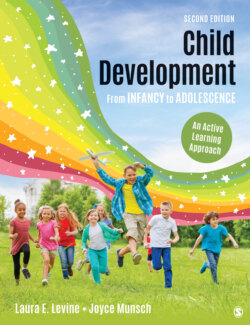Читать книгу Child Development From Infancy to Adolescence - Laura E. Levine - Страница 82
На сайте Литреса книга снята с продажи.
Getting the Most From Your Textbook
ОглавлениеWe are sure you will want to get the most you can from your textbook. We have already told you why you will want to use the True/False Quiz that begins each chapter to identify important ideas that challenge your initial level of understanding, and the Journeys of Research to understand the evolution of scientific thinking on a given topic. Each chapter begins with a set of Learning Questions that relate to the major topics covered in the chapter. They can act as guideposts that will help focus your learning. When you complete each section of the chapter, you will find a set of review questions that will Check Your Understanding. Use the Knowledge Questions as an opportunity to make sure you have a good understanding of that topic before moving on to the next. Critical Thinking will help you be sure that you can use and apply the information, make inferences based on what you have learned, and integrate new ideas with old ones. When you have finished a chapter, you can review and test yourself on what you have learned by using the Chapter Summary, which repeats the Learning Questions from the beginning of the chapter and summarizes the most relevant information on each topic.
The online resources that accompany this text will also support your learning. The eFlashcards can improve your understanding of key terms and mobile-friendly practice quizzes will let you assess your mastery of the chapter material. The resources also include access to SAGE journal articles that have been selected to expand on concepts from each chapter.
Because we all learn best when we can relate new ideas to our own experiences, we also provide a variety of Active Learning features. Some of these activities are designed to help you feel or think the way a child feels or thinks, or reflect on your own experiences while you were growing up. Others allow you to carry out simple experiments or observations with children and adolescents to see for yourself examples of the behaviors we are describing. In the Interactive eBook for this text, you will find videos for many of the Active Learning features that involve children. These videos can help you prepare for doing the activity yourself with a child, or they will let you see how the activity is done if you aren’t planning to do it yourself. On the Student Companion Website, you will find some activities that will test your understanding of material in the chapter and some that will help you learn how to find the kind of information you will need when you are working with children.
All of these activities are designed to help you become engaged with the material so that you can relate it to your own life and gain new insight into various aspects of development. We hope that all these opportunities help you develop a deeper understanding of the material so that your new knowledge will stay with you far beyond the end of the course you are taking and will influence how you understand and interact with children and adolescents in the future.
